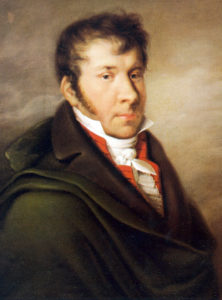Hummel, Septet Op. 74 (1st Movement)
 Johann Nepomuk Hummel (1778-1837) deserves a spot in this series for several reasons, the least of which is that I walk by his house often when I’m in Weimar. He spent the last 20 years of his life in that city as a well-known and respected composer and Kappellmeister. It was Johann Goethe (1749-1832), of course, who turned Weimar into the arts mecca sometimes dubbed the “cultural capital of Europe,” but Hummel contributed significantly to the city’s status as a musical center. Weimar, one of the Bach stations, would later be the home of Franz Liszt and the center of Liszt’s pioneering style.
Johann Nepomuk Hummel (1778-1837) deserves a spot in this series for several reasons, the least of which is that I walk by his house often when I’m in Weimar. He spent the last 20 years of his life in that city as a well-known and respected composer and Kappellmeister. It was Johann Goethe (1749-1832), of course, who turned Weimar into the arts mecca sometimes dubbed the “cultural capital of Europe,” but Hummel contributed significantly to the city’s status as a musical center. Weimar, one of the Bach stations, would later be the home of Franz Liszt and the center of Liszt’s pioneering style.
While Hummel is not terribly famous today, it’s hard not to drop names when talking about him. A virtuoso pianist and protégé of Mozart, he studied also with Clementi, Haydn, and Salieri. He studied alongside Beethoven, with whom he had a lifelong friendship. He assumed Haydn’s duties at Esterházy as Hadyn’s health declined. While playing at Beethoven’s funeral, he met Schubert, who dedicated his last three piano sonatas to him.
His life coincides with that of Beethoven (1770-1827), and he falls mostly in the same category as a transitional composer between the Classical and Romantic eras. But Hummel’s style remained more classical; he did not venture into the expansive forms of Beethoven. Music history followed Beethoven’s path, leaving the once-famous Hummel largely forgotten.
That said, there are many places in the Septet where he expands forms and moves into more Romantic harmonies. I encourage you to listen to all four movements. You can find movements two, three, and four here (same performance). The inner movements in particular retain much of the clarity and grace of Mozart and Haydn, while the last movement falls more on Beethoven’s side of the scale.



